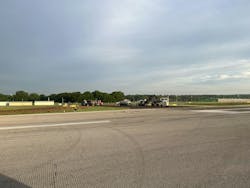Tulsa Riverside Airport Celebrates Completion of Major Taxiway Realignment Project
Tulsa Riverside Airport (RVS) celebrated the completion of the Taxiway Alpha Realignment Project by hosting airport tenants, industry leaders and community members for a ribbon cutting ceremony. The $7.6 million project removed older, angled taxiways and replaced them with right-angled taxiways that meet current FAA design standards.
Project Details
Four connector taxiways between Runway 1L/19R and Taxiway Alpha were completely realigned and rehabilitated, with crews removing the top layer of asphalt and replacing it with new material. The new right-angle turn-offs help prevent faster moving traffic from inadvertently rolling onto the parking area, given Tulsa Riverside Airport’s ramp is in close proximity to the runway. The realignment ensures that aircraft slow to a proper taxiing speed before approaching the parking ramp.
Another benefit of the project is that it brings the geometry in line with current FAA standards. Therefore, the taxiway configurations here will be identical to other airports across the country. Having five flight schools onsite at RVS, this is particularly important for the thousands of student-pilots that train at the airport every year, since they need to train in standard design parameters.
The first phase of construction began in Spring 2023 and the final phase was completed in May 2024, with the primary runways being closed for a combined five months throughout the year. While airport users could always take off and land at RVS throughout the entire project, having the airfield fully open for normal operations again is a relief for airport users.
Funding Sources and Project Costs
o Federal Aviation Administration (FAA) Grant – $6,858,500
o Oklahoma Department of Aerospace & Aeronautics (ODAA) Grant – $381,028
o Tulsa Airports Improvement Trust (TAIT) – $423,928
§ Total cost: $7,663,456
Vendors Used
o Olsson Engineering – Design and Project Management
o APAC Central – Primary Construction Contractor
“'This project not only enhances safety for all our pilots and student pilots, but also aligns our infrastructure with the highest standards set by the FAA,” said Austin Wheeler, Airport Manager at Tulsa Riverside Airport. “We are grateful for the patience and support of our community throughout the two construction phases. With the airfield now fully operational, we look forward to continuing to provide a top-tier training environment and aviation hub for the region.”
“Tulsa Riverside Airport stands as a hub for flight training and aviation businesses for the Tulsa region, fueling the state’s economic activity with three runways, two hundred commercial and private hangars, and over 500 based aircraft,” said Executive Director Grayson Ardies, Oklahoma Department of Aerospace and Aeronautics. “The Riverside Airport also holds the mark as the state’s busiest airport and our agency is proud to support this critical safety project by investing both federal and state funds to support the major realignment of the parallel taxiway system. Oklahoma’s airport system plays a crucial role in supporting the aviation supply chain and by funding projects such as the one we are celebrating today we are investing in our state’s economic progress.”
“The FAA’s Arkansas/Oklahoma Airport District Office applauds the commitment by the Tulsa Airports Improvement Trust and the Tulsa Riverside Airport to improve airfield safety,” said a representative from the FAA’s Arkansas/Oklahoma Airport District Office. “The project improved taxiway to runway connectors to meet current FAA design standards thereby reducing the potential for pilot loss of situational awareness and runway incursions.”
Later this year, the airport will begin the design process for a project that will widen the crosswind runway, 13/31. Construction for this project is expected to start in late 2025-early 2026.



